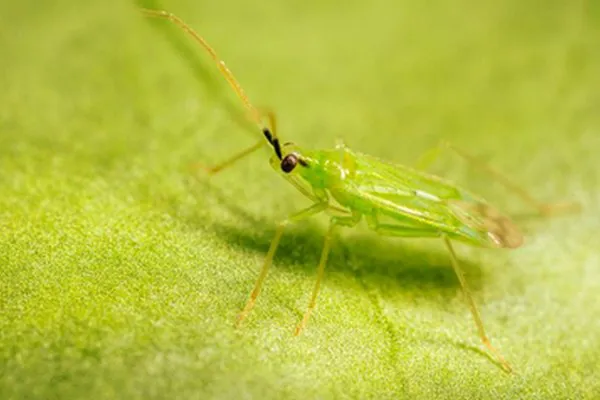At a cultivation site of Van Duijn De Jong Aubergines in Oosterland, the Macrolophus bug is introduced across 2 hectares following a standard regime without any supplementary feeding strategy. A supplementary feeding strategy is implemented at a second site (with a similar variety, planting date, and cultivation regime). All of this is a pilot in eggplant cultivation for the 'greenhouse as an ecosystem' concept.
The predatory bug Macroplophus pygmaeus plays a crucial role in biological pest control in eggplant cultivation. The reason for this is that this generalist predator is preying on a wide range of pest organisms: whiteflies, spider mites, caterpillars, leaf miners, and aphids. These are precisely the pests that eggplant growers would like to control as effectively as possible throughout the cultivation period. Therefore, having the right population build-up at the start is essential.

Predatory bug Macroplophus pygmaeus.
Assisting in population buildup
According to eggplant growers, the usage of Macrolophus does not always take effect. When this is not the case, the bug's considerably long developing time can pose a considerable cultivation risk. This pilot aims to investigate whether the population buildup of Macrolophus can be accelerated by providing alternative food sources, namely Ephestia eggs and Artemisia cysts.
A/B test
At Van Duijn De Jong Aubergines's cultivation site in Oosterland, Macrolophus is introduced across 2 hectares following a standard regime without any supplementary feeding strategy. At a second site, with a similar variety, planting date, and cultivation regime, a supplementary feeding strategy is implemented. This strategy involves selecting representative rows where the Macrolophus is introduced at specific points along the row. This introduction during week 9 and 10 is followed by 6 weeks of supplementary feeding with Ephestia, after which Artemisia is dispersed across the field for another 9 weeks.
Intensive monitoring
To make informed conclusions about the effectiveness of this supplementary feeding method, it is crucial to closely monitor the buildup of both pest organisms and Macrolophus. This is intensively done by the grower and advisor from the Natutec system. Additionally, a sample from the trial is analyzed four times to gather supporting monitoring data. The hours spent on this supplementary feeding strategy are carefully documented, allowing for a thorough evaluation of its effectiveness.
Growers actively involved
Executing a large-scale pilot is an exciting challenge. The eggplant crop group strongly supports testing this supplementary feeding concept provided by Koppert. Although the cultivation company that conducts the pilot will undoubtedly learn the most, the results will be made available to all growers.
Funding
The pilot is carried out as part of the 'Greenhouse as an Ecosystem' pilot program and is funded by the Dutch program 'Plantgezondheid' and the Dutch association 'Kennis in je Kas' (KIJK).
Source: Dutch Greenhouse Horticulture
